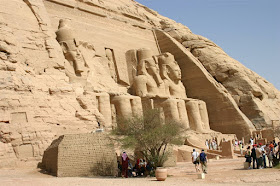The oldest Nubian temples date back to the eighteenth dynasty (Buhen, al-Lessiya, Amada, etc.) while the most recent were erected during the Graeco-Roman period. However, of all the Egyptian Pharaohs, it was under Ramses II (thirteenth century BC) that Lower Nubia witnessed its most intensive period of temple construction. He erected seven temples therein : Beit al-Wali, Garf Hussein, Wadi al-Sebuâ, Derr (the only one on the east bank of the Nile), those of Abu Simbel and, finally, Akcha. The successors of this great ruler of the nineteenth dynasty would not build another temple in Nubia for nealy a millennium to come.
Map of the Great Temple of Ramses II:
1- Terrace.
2- Royal colossi of the Facade-Pylon.
3- Hall with Osirian pillars.
4- Second hall.
5- Northern and southern rooms of Tresor.
6- Vestibule.
7- Lateral rooms.
8- Sanctuary.
Temple of Abu Simbel lies 270 km south of Aswan. In addition to the two cave-temples built by Ramses II, the walls of the surrounding hills feature twenty-eight stelae carved into the rock.
During his trip to Nubia, the Swiss traveller Johann Ludwig Burckhardt – also known as Sheikh Ibrahim ibn Abdallah – was the first Westerner to see « Ebsambal (=Abu Simbel) », on March 22, 1813. After visiting the small temple, he wandered a few tens of meters to the south, and discovered the upper part of the colossi of Ramses II of the Great Temple, still buried under the sand. Thereafter, the Italian Giovanni Battista Belzoni and his team managed to enter the Great Temple of Abu Simbel on Friday, August 1st, 1817, more than three millennia after its construction.
After the construction of the old Aswan Dam (1898-1902) and its subsequent two elevations (1907-1912 and 1929-1934), the water level to the south of Aswan had risen considerably and the temples of Philae had been inundated. The construction of the High Dam (1960-1971), and the huge Lake Nasser which would develop behind it – with an average width of over 10 km, length of 500 km and a total area greater than 6000 km² – would result in the complete submersion of the monuments of Nubia (in both Egypt and Sudan). It was therefore necessary to act quickly to save these temples before they ultimately dissapeared under the water (that is to say, before 1968 for the site of Abu Simbel). The Egyptian authorities and international community reacted quickly : on March 8, 1960, the General Director of UNESCO issued a solemn appeal, thus inaugurating the International Campaign to Save the Monuments of Nubia. It would span twenty years.
Sound and light of Abu Simbel
Temples of Ramesses II and Nefertari
Map of the Great Temple of Ramses II:
1- Terrace.
2- Royal colossi of the Facade-Pylon.
3- Hall with Osirian pillars.
4- Second hall.
5- Northern and southern rooms of Tresor.
6- Vestibule.
7- Lateral rooms.
8- Sanctuary.
Plan of the great temple
Temple of Abu Simbel lies 270 km south of Aswan. In addition to the two cave-temples built by Ramses II, the walls of the surrounding hills feature twenty-eight stelae carved into the rock.
During his trip to Nubia, the Swiss traveller Johann Ludwig Burckhardt – also known as Sheikh Ibrahim ibn Abdallah – was the first Westerner to see « Ebsambal (=Abu Simbel) », on March 22, 1813. After visiting the small temple, he wandered a few tens of meters to the south, and discovered the upper part of the colossi of Ramses II of the Great Temple, still buried under the sand. Thereafter, the Italian Giovanni Battista Belzoni and his team managed to enter the Great Temple of Abu Simbel on Friday, August 1st, 1817, more than three millennia after its construction.
Temple of Abu Simbel
Great temple of Abu Simbel
Part of Abu Simbel temple
Interior of abu simbel
Baboon carvings above the heads of the statues of Ramses
Nefertari with Hathor
Ramses attacke a Syrian fortress (Abu Simbel)
Enemies being beaten by the Egyptians (Abu Simbel)
After the construction of the old Aswan Dam (1898-1902) and its subsequent two elevations (1907-1912 and 1929-1934), the water level to the south of Aswan had risen considerably and the temples of Philae had been inundated. The construction of the High Dam (1960-1971), and the huge Lake Nasser which would develop behind it – with an average width of over 10 km, length of 500 km and a total area greater than 6000 km² – would result in the complete submersion of the monuments of Nubia (in both Egypt and Sudan). It was therefore necessary to act quickly to save these temples before they ultimately dissapeared under the water (that is to say, before 1968 for the site of Abu Simbel). The Egyptian authorities and international community reacted quickly : on March 8, 1960, the General Director of UNESCO issued a solemn appeal, thus inaugurating the International Campaign to Save the Monuments of Nubia. It would span twenty years.
Visitors of Abu Simbel












